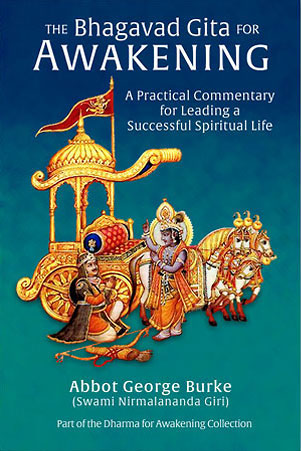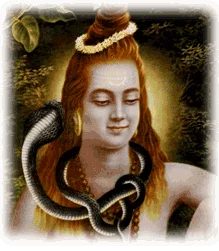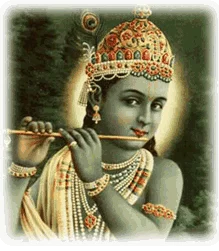
Krishna has more to say about materially oriented scriptures and religion, though he just mentions the Vedas:
The three gunas are the domains of the Vedas. Be free from the triad of the gunas, indifferent to the pairs of opposites, eternally established in reality, free from thoughts of getting and keeping, and established in the Self (2:45).
Again, by “the Vedas” Krishna means the ritualistic portion of the Vedas, the karma-kanda in contrast to the Upanishads, the jnana-kanda, which embody the highest spiritual wisdom and vision ever set down by human beings. They are really two opposing poles, one external and material, the other internal and spiritual. The karma-kanda insists that ritual is the only way to spiritual attainment; the Upanishads affirm exactly the opposite.
Krishna, continuing the theme of the previous verses, insists that however sacred the karma-kanda may claim its rituals to be, they really deal with nothing more than Prakriti, material nature, total involvement with which produces only ignorance and bondage culminating in rebirth.
The gunas
According to Sankhya philosophy, material energy behaves in three modes, or gunas (qualities). We will be considering them at length in Chapter Fourteen, which is entitled “The Yoga of the Division of the Three Gunas.” For now we need only think of them as three forms of material consciousness. Whereas the karma-kanda does nothing more than entangle its adherents in the three gunas, Krishna tells Arjuna that he must overcome the three gunas, that materiality must be transcended by entry into consciousness of the Self (Atman). But it is no easy matter to be free from the bonds of matter. Rather, the gunas must be overcome. This entails a struggle, and not an easy one, either, for Krishna later says to him: “Truly, this maya of mine made of the gunas is difficult to go beyond” (7:14).
The pairs of opposites
The dwandwas, the pairs of opposites, are also material phenomena, such as pleasure and pain, hot and cold, light and darkness, gain and loss, victory and defeat, love and hatred. Usually people think that the ideal is to eliminate one half of a pair and cultivate the other. This is the common attitude of religion throughout the world: seek the “good” and avoid the “bad.” But the sages of India discerned that real wisdom is to be established in the state in which the pairs of opposites cannot affect us. We neither seek one nor shun the other, but see them for the momentary appearances they really are, only mirages cast by our own mind.
The word nirdwandwas means “untouched by–indifferent to–the pairs of opposites,” and also “without the pairs of opposites.” At first we are to be indifferent to them when they insinuate themselves into our experience. But in time we are simply without them–they will have ceased to even exist for us. Then we will not need to endure them: they will have vanished like the dreams they are.
Tranquility
“Eternally established in truth [reality].” A simple phrase, but a profound concept. Later in this chapter it is elucidated by Krishna saying: “With attraction and aversion eliminated, even though moving amongst objects of sense, by self-restraint, the self-controlled attains tranquility. In tranquility the cessation of all sorrows is produced for him. Truly, for the tranquil-minded the buddhi immediately becomes steady” (2:64, 65). This truth is illustrated by an incident from the life of Yogiraj Shyama Charan Lahiri Mahasaya. He continually expounded the idea that the goal of yoga is to be established in sthirattwa, in perfect tranquility.
A group of spiritual leaders in Calcutta once conspired against Lahiri Mahasaya. They invited him to join an evening discussion on spiritual matters. Lahiri Mahasays accepted the invitation and accordingly attended the meeting.
The conspirators had well prepared themselves to trap Lahiri Mahasaya. For example, if Lahiri Mahasaya were to express his preference for a particular deity, or ishta devata, then a particular leader would find exception to that choice.
In fact, each member of the group selected a particular devata (deity) such as Lord Vishnu, Lord Krishna, Lord Siva and the Goddess Kali, and prepared to debate and challenge Lahiri Mahasaya’s choice.
As soon as Lahiri Mahasaya arrived, he was received in the traditional manner and shown proper courtesy. After a while one of the members of the group asked Lahiri Mahasaya, “Upon which deity do you meditate?” Lahiri Mahasaya looked at him but did not reply.
Then another gentleman asked him, “Who is your ishta devata?” Lahiri Mahasaya turned his head towards him and looked at him in the same way, while keeping his peace.
Finally, a third gentleman asked him, “Can you tell us upon which deity you usually meditate?”
Lahiri Mahasaya faced him and said very gently, “I meditate on sthirattva (tranquility).”
The gentleman replied that he did not understand what was meant by this. Lahiri Mahasaya continued to observe silence.
After some time, another gentleman asked him, “Could you please explain this? I do not understand exactly what you are saying.”
Lahiri Mahasaya, as before, continued to maintain silence.
Another gentleman asked, “Can you enlighten me as to what you mean by that? I do not understand at all!” Lahiri Baba told him, “You will not be able to understand, and also I will not be able to make you understand (realize) through words.”
The group was at a loss. All of their preparation and conniving had come to naught. Only silence prevailed. All kept silent.
After a long time Lahiri Mahasaya got up and silently prepared to leave the meeting. All showed him the traditional courtesy as he left.
Here we see how to fulfill Krishna’s counsel: “Be… eternally established in reality.”
Material detachment
Next Krishna utters another simple phrase: “Free from thoughts of getting and keeping.” Frankly, this is such a high ideal there is little to say about it, except that it refers to intangibles as well as tangibles. To transcend the impulse to acquire or keep is itself liberation, for only a liberated consciousness is capable of such a condition (or non-condition). Practically speaking, the best policy is to immerse ourselves in sadhana that leads to liberation. Then we will attain the state Krishna has set forth to us.
Scriptures
For the wise Brahmin with true knowledge, a great deal in all the Vedas are of as much value as a well when there is a flood all around (2:46).
As already said, the Vedas consist of both the karma-kanda, ritualistic expositions, and the jnana-kanda, expositions of the knowledge of the Self–just as other scriptures contain teachings regarding purely external life and also inner, spiritual wisdom. The enlightened need neither of them, both being irrelevant, but for different reasons.
The karma-kanda has been seen to be a force for bondage and therefore rejected by the liberated. The jnana-kanda, the Upanishads, on the other hand, has not been rejected by them. Rather the liberated embody and prove the truth of the Upanishads. For them the Upanishads are like a user’s manual for a machine. Once the operation and maintenance of the machine is learned, the manual is no longer consulted. As long as they were learning, the Upanishads were essential, but once they attained true Knowing, they had no more use.
So the “uselessness” of the karma-kanda and jnana-kanda are of a vastly differing character. I point this out because the two should never be equated. For the jnani the karma-kanda is an obstacle, but the jnana-kanda is a valued though outgrown teacher, a door that is unnecessary only because it has now been passed through.
Yet I must add that I truly believe that no one ever goes beyond the Gita; that it should be our constant companion as long as we exist on this earth plane.
Read the next article in the Bhagavad Gita for Awakening: How Not To Act







